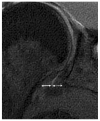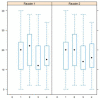MR Imaging Biomarkers for Clinical Impairment and Disease Progression in Patients with Shoulder Adhesive Capsulitis: A Prospective Study
- PMID: 34501330
- PMCID: PMC8432015
- DOI: 10.3390/jcm10173882
MR Imaging Biomarkers for Clinical Impairment and Disease Progression in Patients with Shoulder Adhesive Capsulitis: A Prospective Study
Abstract
Background: MRI diagnostic criteria of shoulder adhesive capsulitis (AC) are nowadays widely used, but there is little information available on the association between MRI findings and clinical impairment.
Purpose: To determine the correlation of MRI findings with the Constant-Murley Score (CMS), pain duration and symptoms at the one-year follow-up in AC patients.
Materials and methods: This monocentric prospective study included 132 patients with a clinical diagnosis of shoulder AC who underwent shoulder MRI. Mean patient age was 54.1 ± 9.3 years, and there were 55 men and 77 women. A radiologist examined all patients and completed the CMS just prior to MRI. Pain duration was assessed along with the signal intensity and measured the maximal thickness of the inferior glenohumeral ligament (IGHL) by two radiologists. Medical record analysis was performed in a sub-group of 49 patients to assess prognosis approximately one year after the MRI examination. Linear regression analysis with the Pearson test and the Fisher exact test were used to determine the association between MRI findings and clinical impairment.
Results: There was a significant difference in mean pain duration score (3.8 ± 1.2 versus 3.2 ± 0.9 and 3.8 ± 1.2 versus 3.2 ± 0.9, respectively, for readers 1 and 2) and in mean mobility scores (15.7 ± 8 points versus 19.6 ± 10.1 points and 15.8 ± 8.2 points versus 19.4 ± 10 points, respectively, for readers 1 and 2) in patients with a high IGHL signal compared to those with a low IGHL signal (p < 0.05). IGHL was thicker in patients with clinical improvement at one-year follow-up compared to those presenting clinical stability or worsening (p < 0.05).
Conclusions: In patients with shoulder AC, the degree of signal intensity at the IGHL was inversely related to shoulder pain duration and range of motion, and a thickened IGHL indicated a favorable outcome at one-year follow-up.
Keywords: MRI; adhesive capsulitis; constant-murley score; inferior gleno-humeral ligament; shoulder.
Conflict of interest statement
The authors declare no conflict of interest.
Figures






Similar articles
-
MR imaging signs of shoulder adhesive capsulitis: analysis of potential differentials and improved diagnostic criteria.Skeletal Radiol. 2025 Jan;54(1):77-86. doi: 10.1007/s00256-024-04677-5. Epub 2024 May 22. Skeletal Radiol. 2025. PMID: 38775948
-
Do the Findings of Magnetic Resonance Imaging, Arthrography, and Ultrasonography Reflect Clinical Impairment in Patients With Idiopathic Adhesive Capsulitis of the Shoulder?Arch Phys Med Rehabil. 2017 Oct;98(10):1995-2001. doi: 10.1016/j.apmr.2017.06.006. Epub 2017 Jul 4. Arch Phys Med Rehabil. 2017. PMID: 28687319
-
Adhesive capsulitis: MRI correlation with clinical stages and proposal of MRI staging.Indian J Radiol Imaging. 2019 Jan-Mar;29(1):19-24. doi: 10.4103/ijri.IJRI_116_18. Indian J Radiol Imaging. 2019. PMID: 31000937 Free PMC article.
-
Systematic review and meta-analysis of magnetic resonance imaging features for diagnosis of adhesive capsulitis of the shoulder.Eur Radiol. 2019 Feb;29(2):566-577. doi: 10.1007/s00330-018-5604-y. Epub 2018 Jul 5. Eur Radiol. 2019. PMID: 29978436
-
Inferior glenohumeral ligament (IGHL) complex: anatomy, injuries, imaging features, and treatment options.Emerg Radiol. 2017 Feb;24(1):65-71. doi: 10.1007/s10140-016-1431-0. Epub 2016 Aug 16. Emerg Radiol. 2017. PMID: 27530740 Review.
Cited by
-
Clinical Practice Guidelines for Diagnosis and Non-Surgical Treatment of Primary Frozen Shoulder.Ann Rehabil Med. 2025 Jun;49(3):113-138. doi: 10.5535/arm.250057. Epub 2025 Jun 30. Ann Rehabil Med. 2025. PMID: 40602400 Free PMC article.
-
MR imaging signs of shoulder adhesive capsulitis: analysis of potential differentials and improved diagnostic criteria.Skeletal Radiol. 2025 Jan;54(1):77-86. doi: 10.1007/s00256-024-04677-5. Epub 2024 May 22. Skeletal Radiol. 2025. PMID: 38775948
-
What is the most predictive magnetic resonance imaging finding of rotator cuff tear concomitant with shoulder stiffness?JSES Int. 2023 May 25;7(5):756-762. doi: 10.1016/j.jseint.2023.05.001. eCollection 2023 Sep. JSES Int. 2023. PMID: 37719831 Free PMC article.
-
Correlation Between Non-Contrast Magnetic Resonance Imaging Findings and Clinical Assessment in Patients With Adhesive Capsulitis.Cureus. 2025 Feb 25;17(2):e79626. doi: 10.7759/cureus.79626. eCollection 2025 Feb. Cureus. 2025. PMID: 40151748 Free PMC article.
-
Can magnetic resonance imaging distinguish clinical stages of frozen shoulder? A state-of-the-art review.JSES Rev Rep Tech. 2024 May 15;4(3):365-370. doi: 10.1016/j.xrrt.2024.05.002. eCollection 2024 Aug. JSES Rev Rep Tech. 2024. PMID: 39157226 Free PMC article. Review.
References
-
- Kelley M.J., Shaffer M.A., Kuhn J.E., Michener L.A., Seitz A.L., Uhl T.L., Godges J.J., McClure P. Shoulder Pain and Mobility Deficits: Adhesive Capsulitis: Clinical Practice Guidelines Linked to the International Classification of Functioning, Disability, and Health From the Orthopaedic Section of the American Physical Therapy Association. J. Orthop. Sports Phys. Ther. 2013;43:A1–A31. doi: 10.2519/jospt.2013.0302. - DOI - PubMed
LinkOut - more resources
Full Text Sources

